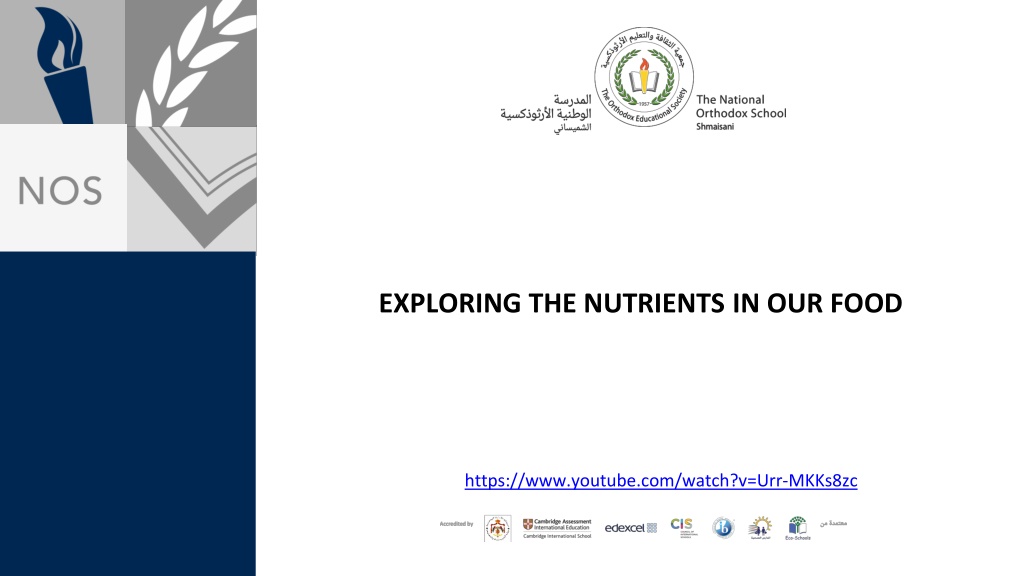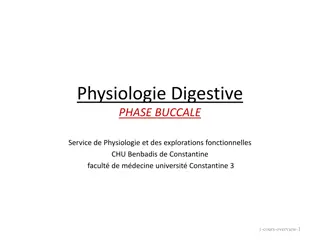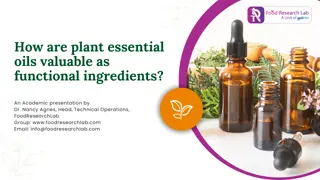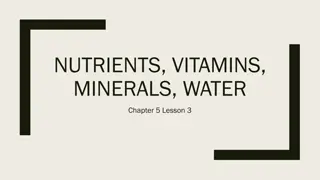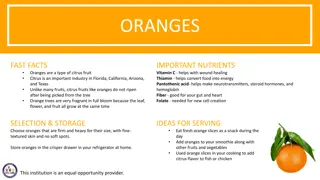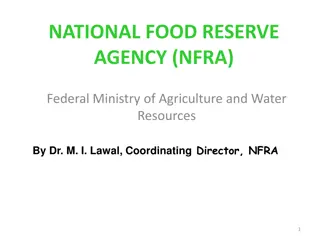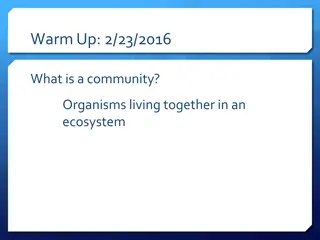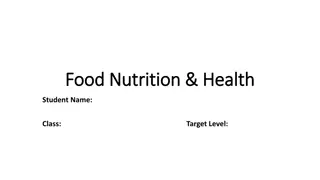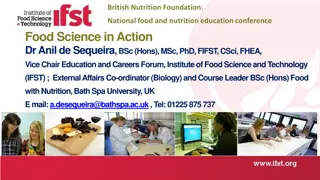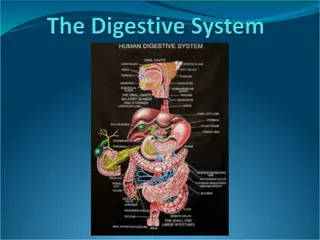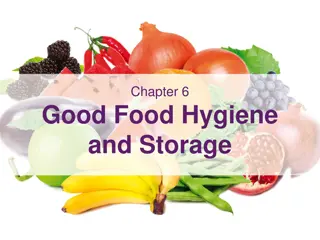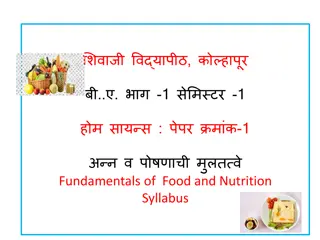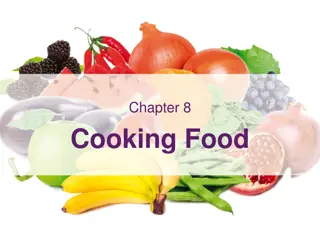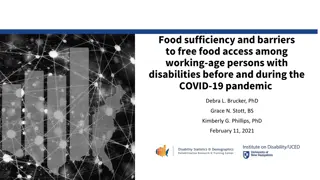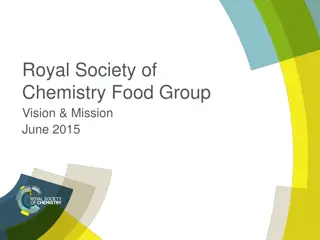Nutrients in Food: A Comprehensive Guide
Discover the importance of nutrients in our food, including carbohydrates, proteins, fats, vitamins, minerals, and more. Learn how each nutrient plays a vital role in providing energy, supporting growth and repair, and facilitating essential cellular functions. Explore different food groups and their nutrient content to make informed dietary choices.
Download Presentation

Please find below an Image/Link to download the presentation.
The content on the website is provided AS IS for your information and personal use only. It may not be sold, licensed, or shared on other websites without obtaining consent from the author. Download presentation by click this link. If you encounter any issues during the download, it is possible that the publisher has removed the file from their server.
E N D
Presentation Transcript
EXPLORING THE NUTRIENTS IN OUR FOOD https://www.youtube.com/watch?v=Urr-MKKs8zc
The importance of nutrients The nutrients in food have 3 roles: They provide materials for growth and repair. Energy to keep your cells alive. Vital elements and compounds to maintain the chemical reactions in your cells. https://www.youtube.com/watch?v=NqV1Ig4_nfI
Nutrients in food Food can generally be classified into the following 7 major groups: Carbohydrates Proteins Fat Vitamins Minerals Fibre Water
Nutrients Food is eaten and digested in the body to allow the absorption of energy and nutrients. There are three macronutrients that are essential for health: carbohydrate protein fat There are two different types of nutrients: macronutrients micronutrients There are two types of micronutrients: vitamins minerals
Carbohydrates (Most of our energy intake should come from this group) Carbohydrates are large molecules , they are digested in the body into smaller molecules called glucose. Glucose is a simple sugar that gives the body a quick burst of energy. The two types of carbohydrate that provide energy are starch and sugars.
Starchy carbohydrate Starch is a carbohydrate that is made of lots of glucose molecules joined together. Starch is found in a variety of foods. Can you give some examples of sources of starch in the diet? Potatoes Bananas Bread Pasta Cereals such as wheat and rice
Proteins Protein is essential for growth, repair and keeping cells healthy. Protein also provides energy. Proteins are large molecules, they are digested in the body into smaller molecules called amino acids.
Structure of protein Proteins are made up of building blocks called amino acids. Different foods contain different amounts and different combinations of amino acids. Protein from animal sources (e.g. meat, fish, eggs and dairy products) contains the full range of essential amino acids needed by the body. Protein from plant sources (e.g. pulses; beans, nuts and cereals) typically contain fewer essential amino acids.
Fats Fats are important as they make cell membranes, protect vital organs, they make cell membranes, protect vital organs, stored source of energy, reduce heat loss from your skin. stored source of energy, reduce heat loss from your skin. Foods that contain a lot of fat provide a lot of energy.
Fats Fats : There are two main types of fat : Saturated : processed food are often high in it (Found in meat, cheese, butter, hot dogs, chips, cookies). ( they increase the risk of heart disease ) Unsaturated : found in fish, nuts ,vegetable oil. ( these are better for your health )
Structure of fat Fats are large molecules , they are digested into smaller molecules called fatty acids and glycerol which can then be absorbed into the blood.
Question: Proteins, fats and starch are large molecules made by joining smaller molecules together. Complete the table to show what is different about each of these small molecules. Nutrient Small molecules joined to make them Starch Glucose Proteins Amino acids Fatty acids + glycerol Fats
Vitamins (Help chemical reactions take place in your cells) There are two groups of vitamins: Fat-soluble vitamins, which are found in fish and dairy products can be stored in the body, e.g. vitamins A and D. Water-soluble vitamins, which are found in fruits and vegetables cannot be stored in the body and are therefore required daily, e.g. B vitamins and vitamin C.
Minerals (Help cells function properly and strengthen bones and teeth) Minerals are required by the body in small amounts for a variety of different functions. The body requires different amounts of each mineral. People have different requirements, according to their Age, gender, physiological state (e.g. pregnancy).
Fibre Fibre is an important part of our healthy diet, but it isn t a nutrient. Fibre is made of large molecules your body can t digest. The fibre in food helps it to pass through your digestive system quickly, so it prevents constipation.
How do we store energy? How do we store energy? Human beings and other animals have two ways of storing energy: Glycogen is a short-term carbohydrate energy store in our muscles and liver. Glycogen is used in the body to give instant energy if the level of sugar in your blood gets low. Fat is a long-term way of storing energy in the body. If we eat more than we need, some of the excess food molecules are converted into fat and stored in special fat cells under the skin and around the organs. If we do not get enough food, our body breaks down our fat stores to give the cells the energy they need.
Question Look at the following statements and use them to complete the table comparing the human storage molecules glycogen and fat. A.a short-term carbohydrate energy store. B.broken down for energy over time if not enough food is eaten. C.stored in special cells under the skin and around the body organs. D.a long-term energy store. E.used for quick, instant energy. F.stored in our muscles and liver. Glycogen Fat B, C, D A, E, F
Kahoot Quiz Kahoot Quiz https://create.kahoot.it/details/617379f9-cae3-4fc5-bfd6- 1e5a7297c9b7 Live worksheet https://www.liveworksheets.com/lr1661485rv
